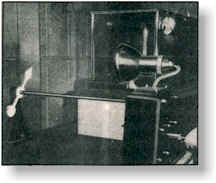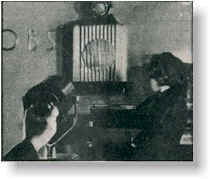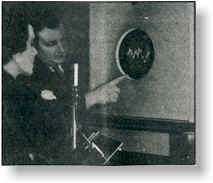|

The moving research exhibits that proved most popular
at the Chicago World's Fair have been collected for this "circus
of science" and to them new wonders have been added.
 (LEFT)
There are stroboscopes, an oscilograph, "electric
eyes," a neon crater tube, a carbon stack indicator, an induction
furnace, a knock-testing motor. (LEFT)
There are stroboscopes, an oscilograph, "electric
eyes," a neon crater tube, a carbon stack indicator, an induction
furnace, a knock-testing motor.
The stroboscopes flicker their neon lights with
incredible speed and fast-moving machinery appears to stand stark
still! Strobocopes are used in industry to study ways of perfecting
high-speed mechanical devices, such as gears, springs, and
crankshafts.
Sound of any kind goes in here, goes 'round and
'round, and comes out here but when it comes out, from an oscillograph,
it is no longer sound, but a waving streak of light.
Scientists use the oscillograph for studying body
squeaks and exhaust noises so that future automobiles may be still
quieter.
 (LEFT)
Music is transmitted on a light beam by means of an
"electric eye," a photo-electric cell. A record turns here
and activates light from a neon crater tube. That varying light
travels across the room and falls on the photo-electric cell which
operates the loud speaker. (LEFT)
Music is transmitted on a light beam by means of an
"electric eye," a photo-electric cell. A record turns here
and activates light from a neon crater tube. That varying light
travels across the room and falls on the photo-electric cell which
operates the loud speaker.
The carbon stock indicator measures pressures or
distances as small as a millionth of an inch. One is attached to a
section of a standard railway rail. You press the rail gently and the
indicator does the rest. Put your warm hand on the rail and indicator
will record the expansion of the steel." This device is used in
industries where extremely accurate measurements are necessary.
Though cool to the touch, the induction furnace will
boil water in a teakettle on its surface. It will flash sparks and
make aluminum rings jump into the air. The secret is quite simple, as
explained in the exposition truck where it is operated.
 At the "General Motors Parade of Progress,"
a view into a running gasoline motor is shown to the public for the
first time. You look through a quartz window and see the four cycles
carried out -- intake, compression, explosion, and exhaust, first with
ordinary gasoline, then with ethyl. You can readily detect which has
the more "knock." At the "General Motors Parade of Progress,"
a view into a running gasoline motor is shown to the public for the
first time. You look through a quartz window and see the four cycles
carried out -- intake, compression, explosion, and exhaust, first with
ordinary gasoline, then with ethyl. You can readily detect which has
the more "knock."
(LEFT)
A demonstration of "voice" being transmitted on light waves. |